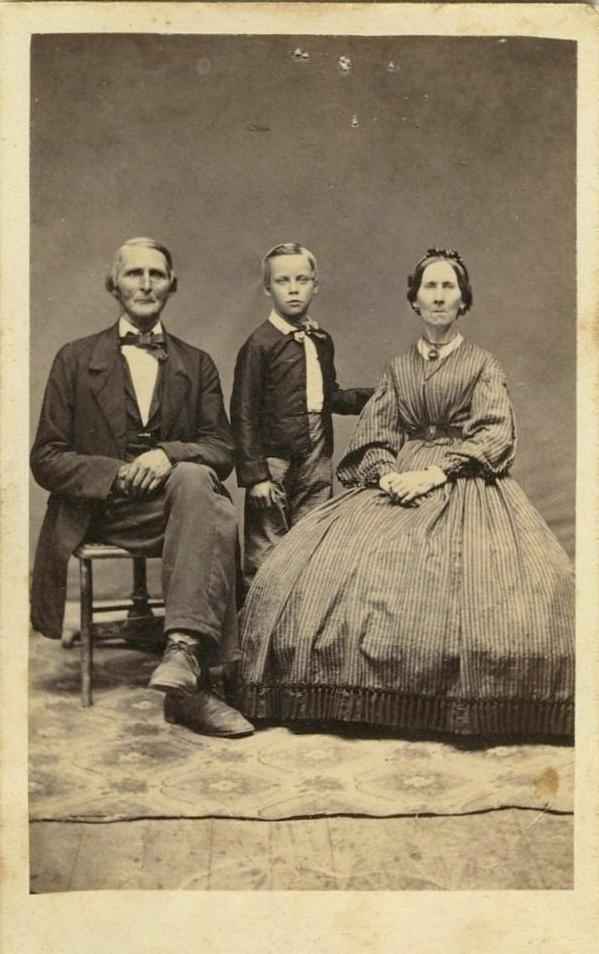
Dating CDVs: Blank Front Mounts

Figure 1.-- The Americam family depicted here in a blank CDV here is unidentified. We do know that they were from Coopertown, New York because of the printed back. The printing is very simple as was common in 1860s CDVs. And we know that it was taken some time during 1864-66 because of the Federal revenue stamp on the back. We also notice a lot of blank fronts in the 1870s, especially in America. The man's stock and woman's hoop skirt are aslso good indicators of the 1860s.
|
|
One guideline is that many of the early CDVs did not have printed lettering identifying the studio. Our general assessment is that the CDVs without printing are probably from the 1860s or 70s. An example here is an undated CDV of an American boy, Dan Brown. We would guess it was taken in the 1870s. These cards might have rules, but not printed lettering on the front. Often they did have printed lettering on the back, although the printing on the back was very basic for early cards. A good example is an American boy in 1865. We note quite a few cards from the 1860s that had blank fronts. This was much less common for later mounts, but we are not yet quite sure just how common this was in subsequent decades, nor do we know how this varied frim country to country. There is also the question of the card backs. We do not images of the backs to all the cards we have archived. Many of the blank fronts did have studio information on the back, but many were also blank on the back. There were also backs without studio information, but with designs like floral patterns. We do not yet know how to date them.
Blank Fronts
One guideline is that many of the early CDVs did not have printed lettering identifying the studio. This seems especially common in the 1860s when CDVs first appeared. Many of the early cards also did not have any border or rules. Except for the image thaey were completely blank. Our general assessment is that the CDVs without printing are probably from the 1860s or 70s. An example here is an undated CDV of an American boy, Dan Brown. We would guess it was taken in the 1870s. We note quite a few cards from the 1860s that had blank fronts. This was much less common for later mounts, but we are not yet quite sure just how common this was in subsequent decades, nor do we know how this varied frim country to country. We are still developing our informtion, but we believe blank fronts are less common in the 1870s.
Blank Fronts with Borders and Rules
These blank cards might have rules, but not printed lettering on the front. We are not yet sure about dating these crds, but we are collecting information on borders and rules.
Often CDVs with blank fronts did have printed lettering on the back, although the printing on the back was very basic for early cards. This appears to have been the case from a basic early period. A good example is an American boy in 1865. In soon became much more elaborate. We note by the 1870s very fancy printed backs with fanvy lettering, designs, and scrolls. We also notice backs done in dark colors with light-colored printing. There may be country fifferences here. We note many British cards included the name of the studio and city in the 1870s. This seems less common in America where we see quite a number of CDVs with blank fronts in the 1870s.
Blank Fronts with Blank Backs
Many of the blank fronts did have studio information on the front, but many were also blank on the back. Here we mean the backs were absolutekly blank. We do not have any 1850s CDVs. Many American CDVs from the 1860s had blank backs. We believe that this was less common by the 1870s, but we are not yet sure to what extent the blank backs persisted.
We do not know about the 1850s. We do have a number of CDVs from the 1860s and we note blank bavks which have been stamped by the photographer with his name and often the address. I'm not sure theu had rubber syamps, but they clearly had sime kind of stap with printing. This idea seems to have been adopted in America almost as soon as CDVs appeared. I'm less sure about Europe. Card stock with the photographer's name were not commonly avaolable at first. Some photographers wrote in the negative number here. We do not yet know to what extent this continued in later decades. With printed fronts and backs of course it became less necessary.
Blank Front with Pattern Backs
There were also backs without studio information, but with designs like floral patterns. We do not yet know how to date them.
HBC

Navigate the Boys' Historical Clothing Web Site:
[Return to:Main CDV mount dating page]
[Introduction]
[Activities]
[Biographies]
[Chronology]
[Clothing styles]
[Countries]
[Bibliographies]
[Contributions]
[FAQs]
[Glossaries]
[Satellites]
[Tools]
[Boys' Clothing Home]
Navigate the Boys' Historical Clothing Web Site:
[Sailor suits]
[Sailor hats]
[Buster Brown suits]
[Eton suits]
[Rompers]
[Tunics]
[Smocks]
[Pinafores]
Created: 12:30 AM 2/23/2007
Last updated: 12:30 AM 2/23/2007



